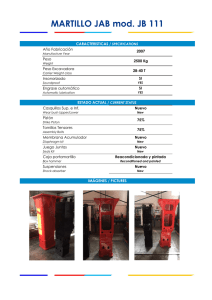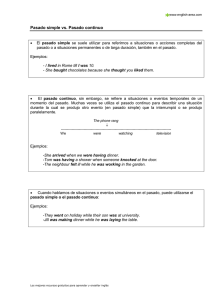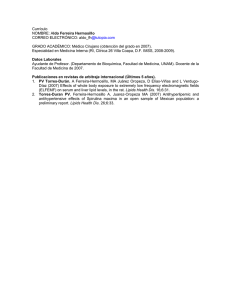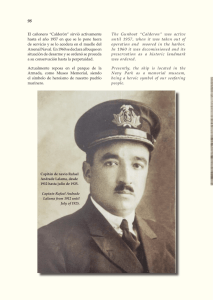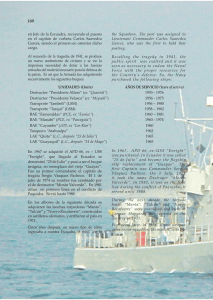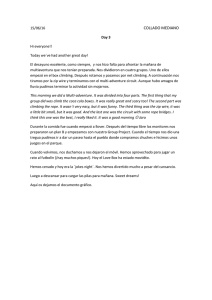Rafael A. Cruz` y Carlos R. Villalobos" A great deal of work has been
Anuncio
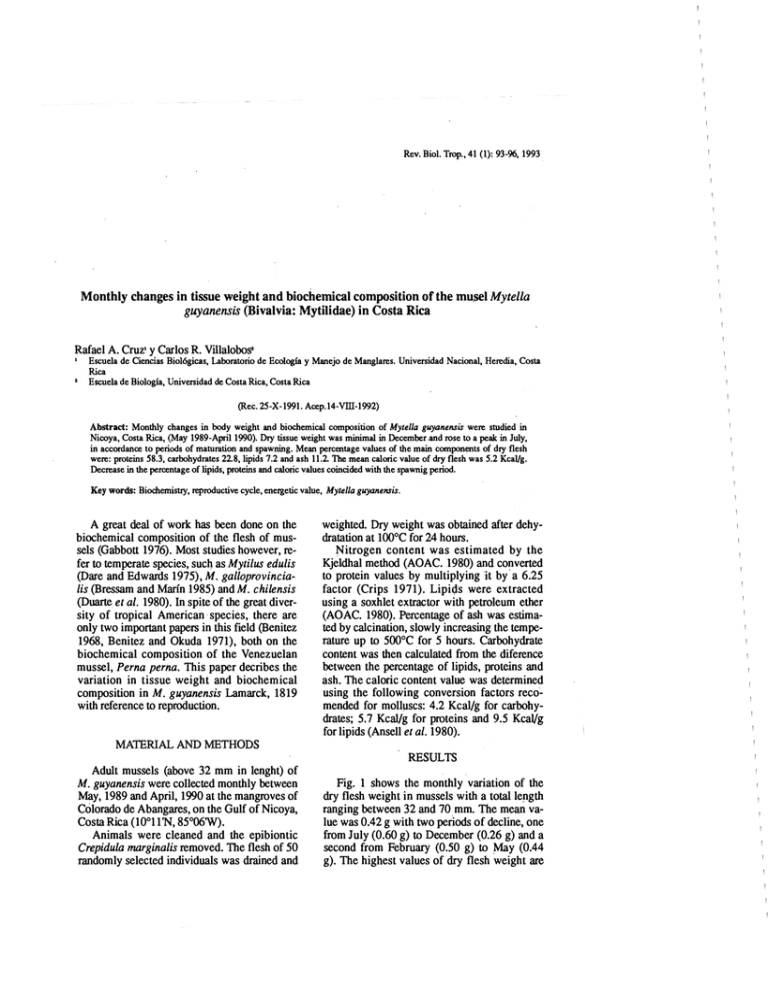
Rev. Biol. Trop., 41 (1): 93-96, 1993 . Montbly changes in tissue weigbt and biochemical composition oC tbe muselMytella guyanensis (Bivalvia: Mytilidae) in Costa Rica Rafael A. Cruz' y Carlos R. Villalobos" , Escuela de Ciencias Biol6gicas, Laboratorio de Ecología y Manejo de Manglares. Universidad Nacional, Heredia, Cosu • Rica Escuela de Biología, Universidad de Costa Rica, Costa Rica (Rec. 25-X-1991. Acep.14-vm-I992) Abstr&ct: Monthly changes in body weight and biochemica1 composition of Mytella guyanellSis were studied in Nicoya, Costa Rica, (May 1989-Aprill990). Dry tissue weight was minimal in Decemberand rose to a peak in luly, in accordance to periods of maturation and apawning. Mean percentage values of tbe main components oí dry flesh were: proteína 58.3, carbohydrates 22.8,lipida 7.2 and ash 11.2. The mean ca10ric va1ue of dry flesh was 5.2 KcaVg. Decrease in tbe percentage oí lipids, proteíns and ca10ric values coincided witb tbe spawnig periodo Key words: Biochemistry, reproductive cyc1e, energetic value, Mytella guyanelisis. A great deal of work has been done on the biochemical composition of the flesh of mus­ seis (Gabbott 1976). Most studies however, re­ fer to temperate species, such as Mytilus edulis (Dare and Edwards 1975), M. galloprovincia­ lis (Bressam and Marin 1985) and M. chilensis (Duarte et al. 1980). In spite of the great diver­ sity of tropical American species, there are only two important papers in this field (Benitez 1968, Benitez and Okuda 1971), both on the biochemical composition of the Venezuelan mussel, Perna p erna. This paper decribes the variation in tissue weight and biochemical composition in M. guyanensis Lamarck, 1819 with reference to reproduction. MATERIAL AND METHODS Adult mussels (above 32 mm in lenght) of M. guyanensis were collected monthly between May, 1989 and April, 1990 at the mangroves of Colorado de Abangares, on the Gulf of Nicoya, Costa Rica (10011'N, 85006W). Animals were cleaned and the epibiontic Crepidula mlJrginalis removed. The flesh of 50 randomly selected individuals was drained and weighted. Dry weight was obtained after dehy­ dratation at 100°C for 24 hours. Nitrogen content was estimated by the Kjeldhal method (AOAC. 1980) and converted to protein values by multiplying it by a 6.25 factor (Crips 1971). Lipids were extracted using a soxhlet extractor with petroleum ether (AOAC. 1980). Percentage of ash was estima­ ted by calcination, slowly increasing the tempe­ rature up to 500°C for 5 hours. Carbohydrate content was then calculated from the diference between the percentage of lipids, proteins and ash. The caloric conteot value was determined using the following conversion factors reco­ mended for moIlJlscs: 4.2 KcaJ/g for carbohy­ drates; 5.7 KcaJ/g for proteins and 9.5 KcaJ/g for lipids (AnseIl et al. 1980). . RESULTS Fig. 1 shows the month1y variation of the dry flesh weight in mussels with a totallength ranging between 32 and 70 mm. The mean va­ lue was 0.42 g with two periods of decline, one from luly (0.60 g) to December (0.26 g) and a second from February (0.50 g) to May (0.44 g). The highest values of dry flesh weight are 94 REVISTA DE BIOLOGIA TROPICAL coincident with the maximum sexual matura­ tion time as described by Cruz and Villalobos (1991 in press). 2 �: : j 84j 0.3 0.6 -, I DRY TlS5UE WEI6HT 1'�_____________ 1::1 � ��----- � WATER A S O N D 32 .� 27 Vl UJ rt 22 �I-���I �I �I�I �I -'-�I �� I I M ... :55:71j� 10127 1"-1 �10�1 :] F M A Fig.l. Mytella guyalUlnsis. Seasonal changes in <by IÍssue weight and water content; Y axis: months. Continuous spawning was observed throug­ hout the year with two main peales, one betwe­ en September and November and a second one from February through March. Mean montbIy values in water content, gross biochemical composition and caloric content are given in Table 1. Mean water content was 80.4 % with a maximum in November (83.4 %) and a mini­ mum in September (76 %). It decreased from May through September and then increased un­ tU November after which it stabilized (Pig.l). The percentage of proteins, carbohydrates, lipids and ash are shown in Fig. 2. Proteins ex­ hibits two peaks of maximum accumulation. The first begins in May (52.3 %) with a maxi­ mum in JuIy (60.5 %). The second one begins in October (53.6%) and ends in April, with a maximum in December (68.7%). Carbohydrates show the values higher in May (27.3%), September (30.5%), October (29.9%) and April (30.9%), precisesly in the same months in which proteins exhibit !he mi­ nimum values (r=-O.94,P>O.05). Lipids represent the smaller fraction (4.612.7%), decreasing from June (12.7%) through October (4.5%). 1t declines agaín f rom December (8.1%) 10 March (6.4%). The percentage of ash did not show any 00rrelation with the monthly fluctuation of the ot­ her oomponents. Mean value was 11.2 % with a maximum of 12.2 % in November and a míni­ mum of9.6 % in December. The mean caloric value for M. guyanensis was 5.22 Kcal/g (TabIe 1), which agree with values reported for other aquatic invertebrates (Winberg 1971) and for mussels in general >- g¡ u. 9 "''---.,. 49 47 �<T-' I --rl -r� l �r-r-��-r�� M J J A N D J F M A Pig. 2. MyteJIa guyalUlnsis. Seasonal changes in the biochemnical lipids. proteín, carbohydrate. alb. and caloric content; Y axis: months. TABLE 1 Biochemical compositiolland caloric values from dryflesh of the tmlSsel MyteUa guyanensis in Costa Rica Components (as % dry weight) Cal. values Month water % Protein Carbohyd. Lipids Ash Kcal/g May 80.2 52.2 27,4 8.9 11.5 4.9 lWle 79.3 58.4 21.7 12.7 10.8 5.2 JuIy 81.2 60.5 18.3 10.8 10,4 5.2 Aug. 77.5 58.7 23.5 6.3 11.5 4.9 Sept. 4.7 76.0 53.0 30.5 4.6 11.9 Oct. 78.7 53.6 29.0 4.6 11.9 4.7 Nov. 83,4 56.9 23.1 7.8 12.2 4.9 13.6 8.1 19.6 5.2 Dec. 83.0 68.7 Jan. 80.6 66.5 15.0 7.6 10,4 5.1 Feb. 81.4 64.0 17.1 6.8 12.1 5.1 Mar. 82.1 59.3 23.3 6,4 11.0 4.9 Apr. 81.6 51.5 30.9 6.8 10.8 4.8 CRUZ, R.A. & C.R. VILLALOBOS: Tissue weight and composition of Myle//a (Dare and Edwards 1975). The caloric values varied monthly (Fig. 2) showing peaks in June, JuIy and December (5.2 Kcal/g), at the same ti­ me when proteins exhibits the highest values and just before the onset of spawning. 95 ACKNOWLEDGMENTS The manuscript was critically reviewed by J. Jiménez of the Universidad Nacional; his com­ ments and suggestions are greatly appreciated. The assistance of E. Lizano is gratefully ack­ nowledged. DISCUSSION RESUMEN M ytell a guyanensis exhibits two reproducti­ ve peaks during the year. Considering that mo­ Uuscs show a cycle of reproductive activity and that energy derived from food is stored to meet the requeriments of gametic production (Giese and Pearse 1974) it is possible to assert, as sug­ gested by Bayne (1976), that there exists a bio-. chemical cycle closely related with the gameto­ genic cycle (Taylor and Venn 1979, Chaparro and Winter 1983). The .lower percentages observed in lipids and proteins during spawning time are in accor­ dance with the results obtained in other studies, such as the one by Gabbott (1976), Peiters e t al. (1980), Davis and Wilson (1983) and Bressan and Marín (1985). These are important organic constituent of molluscan oocytes (Lucas and Benninger 1985). In M. guyanensis, the level of carbohydrates vary inversely with those of proteins; similar results ha-ve be en obtained by Benítez and Okuda (1971) in Perna perna, Dare and Edwards (1975) in M ytilu s edulis and by Bressan and Marín (1985) in M. g all oprovin­ cialis. Decreasing values of carbohydrates are primarily related lO conversion into lipids du­ ring gametogenesis, as suggested by Gabbott (1976). Previous studies have shown that an increa­ se in water content is indicative of spawning (Nair and Saraswasthy 1970, Ansell 1972, Pekkarinen 1983) and this is confirmed by the present study. Sidwell et al. (1979) suggested that high va­ lues of inorganic components may be related to water salinity. In M. guyanensis, however, we did not find a significant relationship between for instance- the percentage of ash and salinity (r=0.19;P<0.05). The caloric value decreased during spaw­ ning and the observed fluctuations, as sugges­ ted by Tyler (1978) and Shafee (1981), should be related to the formation of gamets and spaw­ ning processes. Se estudió la variación mensual del peso de la carne y composición bioquímica (proximal) de M. guyanensis. El peso seco de la carne fue mínimo en diciembre y máximo en julio en concordancia con los períodos de madurez y desove. El promedio de los componentes en ba­ se seca fue: proteínas 58.3 %, carbohidratos 22.8 %, lípidos 7.2 % y cenizas 11.2 %. El va­ lor promedio del valor calórico fue 5.2 KcaVg. REFERENCES Ansel!, A.D. 1972. Distribution growth and seasonal chan­ ges in biochemical composition for the bivalve Donax viUalus (Da Costa) from Kames Bay, Millpon. J. Exp. Mar. Biol. Eco!. !O: 137-150. Ansell, A.D., L. Frenkield & M. Moueza. 1980. Seasonal changes in tissue weight and biochemical composition for the bivalve Donax Irunculus L. on the Algerian co­ ast. J. Exp. Mar. Biol. Eco!. 45: 105-116. AOAC. 1984. Official methods of analisys of the Association oC Agricultural Chemists. Washington D.C. 1141 p. Bayne, B.L. 1976. Aspects of reproduction in bivalve mo­ lluscs. p. 432-448. In M. Wiley (ed.). Estuarine proces­ ses, Academic, New York. Benítez, J. 1968. Variación mensual de la composición quí­ mica del mejillón Perna perna (L). Bo!.lnst. Oceanogr. Univ. de Oriente 7: 37-47. Benítez, 1. & T. Okuda. 1971. Variación estacional de la composición química del mejillón Perna perna (L) Nalura!. Bol.lnst. Oceanogr. Univ. de Oriente 10: 3-8 Bressan,M. & M.G. Marin. 1985. Seasonal variations in biochemical composition and condition index of cultu­ red mussels (Mylilus galloprovincialis Lmk) in the lago· on of Venice (North Adriatic) Aquaculture 48: 13-21. Chaparro, O.R. & J.E. Winter. 1983. The effect of winter period, gametogenesis and spawning of the caloric con­ tent of soft pans in Mylilus chilensis. Aquaculture 32: 419-422. Crips, D.J. 1971. Energy flow measurements, p. 197-278. In N.A. Hohne and A. D. McIntyre (eds.). Methods for 96 REVISTA DE BIOLOGIA TROPICAL Ihe study of marine benlhos, LB.1'. Handbook. No 16, . Blackwell, Oxford. Cruz, R.A. & c.R. Villalobos. 1991. Shell lenglh at sexual maturity and spawning cycle of Mytella guyanensis (Bivalvia: Mytilidae) from Costa Rica. Rev. Biol. Trop. (in press). Dare, P.J. & D.B. Edwards. 1975. Seasonal changes in flesh weight and bíochemical composition of mussels (Mytilus edulis) in Ihe Conwy Estuary, North Wales, J. Exp. Mar. Biol. Ecol. 18: 8979 7. ¡ Davis, J.1'. & J.G. Wilson. 1983. Seasonal changes in tissue weight and biochemical composition of ¡he bivalve Nucula (urgida in Dublin Bay wilh reference lO game­ lOgenesis. Nelh. J. Sea Res. 17: 84-95. Duarte, W.E., F. Tara & C.A. Moreno. 1980. Contenido energético de algunos invertebrados bentónicos de la costa de Chile y fluctuatión anual de Mylilus chilensis Hupé 1854. Bol. Inst. Oceanogr. S.Paulo 29: 273-278. Gabbott, P.A. 1976. Energy metabolismo p. 293-355. 1 n B.L. Bayne (ed.). Marine Mussels: Iheir ecology and phisiology. Cambridge University, Cambridge. Giese, A.C. & 1.S. P earse. 1974. Introduction, general prin­ cipIes, p. 1-41. In A. C. Giese y J.S. Pearse (eds). Reproduction of Marine Invertebrates, Academíc, New York. Lucas, A. & P.G. Benninger. 1985. The use of physiologi­ , cal condition índices ín marine bivalve aquaculture. Aquaculture 44: 187-200. Nair, N.B. & M. Saraswalhy. 1970. Some recents studies on Ihe shipworms of India, Symp. Mollusca. Cochin, 1968, Mar. Biol. Assoc. India, Symp. Ser. 3, part 3, p. 718-729. P ekkarinen, M. 1983. Seasonal changes in condítion and biochemical constituens in Ihe soft parts of Macona balthica (Lamellibranchiata) in the Tvanninenebrackish water area (Baltic Sea) Ann. 1..001. Fennici 20: 311-322. P íeters, H., J.H. Klytmans, D.I. Zandee & G.c. Caddé. 1980. TIssue composítion and reproduction of Mytilus edulis in relation to food availabilíty. Netherl. J. Sea Res. 14: 349-361. Shafee, M.S. 1981. Seasonal changes in Ihe biochernical composition and calorific content of Ihe black scallop Chlamis var ia ( L) frorn Lanveoc, Bay of Brest. Oceanol. Acta 4: 331-341. Sidwell, V.D., A.L. Loonis & R.M. Grodner. 1 979. Geographical and rnonlhly variation in composition of oysLers, Crassostrea virginica. Mar. Fish. Rev. March: 13-17. Taylor, A.e. & T.J. Vem. 1979. Seasonal variation in weight and biochemical composition of Ihe tissues of Ihe queen scallop, Chlamis opercularis, from ¡he Oyde Sea area. J. Mar. Biol. Assoc. U.K. 59: 605-621. Tyler, A. 1973. Calorific values of sorne North Atlantic Invertebrates. Mar. Biol. 19: 258-261. Winberg, G.G. 1971. Melhods for Ihe stimation of produc­ tion of aquatic animals. Academic, New York. 1755 p.
